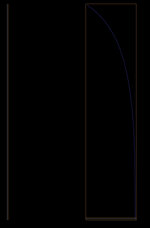V
vonhofs
Guest
I have been asked if I could model a curve using a Lamé equation. The equation actually has two different equations with two missing values, one being the Z direction and the other being the radius (that is my belief so far).
Any ideas on how to get this into a model such that when the Z value is driven from 0 (or a negative number to start the curve on the correct trajectory) to say 7?
Rh=3.36
L2H=5.65
Rleh=2.1
n=3.5
A = L2H * (1 - (Rleh/Rh)^n)^(1/n)
Lame function:
(R / Rh)^n + ( Z / A)^n = 1
FYI: https://en.wikipedia.org/wiki/Lamé_function
Any ideas on how to get this into a model such that when the Z value is driven from 0 (or a negative number to start the curve on the correct trajectory) to say 7?
Rh=3.36
L2H=5.65
Rleh=2.1
n=3.5
A = L2H * (1 - (Rleh/Rh)^n)^(1/n)
Lame function:
(R / Rh)^n + ( Z / A)^n = 1
FYI: https://en.wikipedia.org/wiki/Lamé_function

